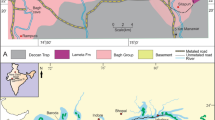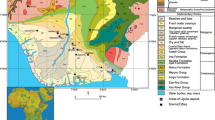Abstract
The term hardground refers to a surface of synsedimentary lithification associated with non-deposition or slow sedimentation. This paper introduces a marine hardground with characteristic microscopic properties in the Pennsylvanian Atoka bank carbonates, which forms a stratigraphic trap for natural gas. The algal bank complex includes several elongated biostromes up to 21 m thick, oriented normally to the paleo-shelf margin. Several lithofacies have been identified in the bank carbonates and surrounding sediments: crinoidal limestone (grainstone/packstone), nodular shaly limestone (wackestone/mudstone), bank margin (grainstone/boundstone), algal bank (wackestone), brecciated limestone, basal bioclastic micritic pile (wackestone), limy shale, and black shale. Phylloid alga, Archaelithopyllum, is the main fossil component in the bank complex and indicates deposition in a shallow marine environment at depths less than 30 m. The other fossils found with phylloid algae such as bryozoans, brachiopods, and echinoderms (sessile benthic suspension feeders) and small benthic foraminifers point out an open shelf environment away from clastic input. The hardground in the carbonates is characterized by an irregularly eroded surface capping well-lithified peloidal grainstone including scattered phylloidal algal plates and overlain by phylloid algal plates and large brachiopod fragments which are extending subparallel to the bedding surface. When the bank complex during the growth approaches to wave base, that increases agitation in the environment and erosion at the upper surface of the banks. Furthermore, agitation leads to the lithification of the peloidal sediments which decreases from the hardground surface into the sediments. Micro-borings penetrate downward into the lithified sediments. The poorly lithified bioclastic sediments with marine internal lime silts in the sheltered pores just above the hardground surface gradually pass upward into algal wackestone and reflect deepening conditions in the environment.






Similar content being viewed by others
References
Aissaoui DM, Purser BH (1983) Nature and origins of internal sediments in Jurassic limestones of Burgundy (France) and Fnoud (Algeria). Sedimentology 30:273–283
Bathurst RGC (1975) Carbonate sediments and their diagenesis, 2nd edn. Dev Sedimentol 12:658. Elsevier Publishing Co., Amsterdam
Carson GA, Crowley SF (1993) The glauconite-phosphate association in hardgrounds: examples from the Cenomanian of Devon, Southwest England. Cretaceous Res 14:69–89
Chafetz HS (1986) Marine peloids: a product of bacterially induced precipitation of calcite. J Sediment Petrol 56:812–817
Christ N, Immenhauser A, Wood RA, Darwich K, Niedermayr A (2015) Petrography and environmental controls on the formation of Phanerozoic marine carbonate hardgrounds. Earth Sci Rev 151:176–226
Dickson JAD (1965) A modified technique for carbonates in thin section. Nature 205:587
Dunham RJ (1962) Classification of carbonate rocks according to depositional texture. In: Classification of carbonate rocks (Ed. W.E. Ham). Am.Assoc Pet Geol Mem 1: 108–121
Embry AF, Klovan JE (1971) A late Devonian reef tract on northeastern Banks Island NWT. Bull Can Pet Geol 19:730–781
Enpu G, Samankassou E, Changqing G, Yongli Z, Baoliang S (2007) Paleoecology of Pennsylvanian phylloid algal buildups in south Guizhou, China. Facies 53:615–623
Eren M (1993) Petrophysical study of Atoka carbonate bank complex Eddy County, New Mexico. Dissertation, Texas Tech University
Eren M (1998) Origin of peloids in Pennsylvanian Atoka carbonates, Eddy County, New Mexico. Giorn Geol 60:197–203
Eren M, Taslı K (2002) Kilop Cretaceous hardground (Kale, Gümüşhane, NE Turkey): description and origin. J Asian Earth Sci 20:433–448
Garrison RE, Kennedy WJ, Palmer TJ (1987) Early lithification and hardgrounds in Upper Albian and Cenomanian calcarenites, southwest England. Cretaceous Res 8:103–140
Given RK, Wilkinson BH (1985) Kinetic control of morphology, composition, and mineralogy of abiotic sedimentary carbonates. J Sediment Petrol 55:109–119
Gong E, Samankassou E, Guan C, Zhang Y, Sun B (2007) Paleoecology of Pennsylvanian phylloid algal buildups in south Guizhou, China. Facies 53:615–623
Grădinaru M, Lazăr I, Panaiotu CE (2011) Preliminary report on the microfacies analyses of the hardgrounds and condensed horizons associated to the middle Jurassic deposits from Tătarului Gorges (Bucegi Mountains, SE Carpathians). Acta Palaeontologica Romaniae 7:169–175
Gruszczyński M, Coleman ML, Marcinowski R, Walaszczyk I, Isaacs MCP (2002) Palaeoenvironmental conditions of hardgrounds formation in the Late Turonian-Coniacian of Mangyshlak Mountains, Western Kazakhstan. Acta Geol Pol 52:423–435
Heckel PH, Cocke JM (1969) Phylloid algal-mound complexes in outcropping Upper Pennsylvanian rocks of Mid-Continent. AAPG Bull 53:1058–1074
Hills JN (1984) Sedimentation, tectonism, and hydrocarbon generation in Delaware Basin, West Texas and Southeastern New Mexico. AAPG Bull 68(3):250–267
Jach R (2005) Storm-dominated deposition of the Lower Jurassic crinoidal limestones in the Krížna unit, Western Tatra Mountains, Poland. Facies 50:561–572
James AD (1985) Producing characteristics and depositional environments of Lower Pennsylvanian reservoirs, Parkway-Empire South area, Eddy County, New Mexico. New Mexico AAPG Bull 69(7):1043–1063
Jones TS (1953) Stratigraphy of the Permian Basin of west Texas. West Texas Geol Soc: 63 p
Keller GR, Hills JM, Djeddi R (1980) A regional geological and geophysical study of the Delaware Basin, New Mexico and west Texas. New Mexico Geological Society Guidebook, 31st Field Conference, Trans-Pecos Region, pp. 105–111
Konishi K, Wray JL (1961) Eugonophyllum, a new pennsylvanian and Permian algal genus. J Paleontol 35:659–667
Krainer K, Vachard D, Lucas SG, Ernst A (2017) Microfacies and sedimentary petrography of Pennsylvanian limestones and sandstones of the Cerros de Amado area, east of Socorro (New Mexico, USA). Bull N M Mus Nat Hist Sci 77:159–198
Lee JH, Chen J, Woo J (2015) The earliest Phanerozoic carbonate hardground (Cambrian Stage 5, Series 3): implications to the paleoseawater chemistry and early adaptation of hardground fauna. Palaeogeogr Palaeocl 440:172–179
Macintyre IG (1977) Distribution of submarine cements in a modern Caribbean fringing reef, Galeta Point, Panama. J Sediment Petrol 47:503–516
Maillet M, Huang WT, Li X, Yang ZY, Guan CQ, Zhang YL (2021) Late Pennsylvanian carbonate platform facies and coral reef: new insights from southern China (Guizhou Province). Facies 67:3
Marshall JF, Davies PJ (1981) Submarine lithification on windward reef slope: Capricorn-Bunker Group, southern Great Barrier Reef. J Sediment Petrol 51:953–960
Moore CH (1989) Carbonate diagenesis and porosity. Developments in Sedimentology 46, Elsevier, Amsterdam
Mutti M, Bernoulli D (2003) Early marine lithification and hardground development on a Miocene ramp (Maiella, Italy): key surfaces to track changes in trophic resources in nontropical carbonate settings. J Sediment Res 73:296–308
Nicolaides S, Wallace M (1997) Submarine cementation and subaerial exposure in Oligo-Miocene temperate carbonates, Torquay Basin, Australia. J Sediment Res 67:397–410
Oborny SC, Cramer BD, Heckel PH, Ludvigson GA, Henthorne RW (2017) Development of phylloid-algal carbonate monds during regression: expanding the build-and-fill model. J Sediment Res 87:688–706
Olszewska-Nejbert D (2004) Development of the Turonian/Coniacian hardground boundary in the Cracow Swell area (Wielkanoc quarry, Southern Poland). Geol Q 48:159–170
Paul A, Lokier SW (2017) Holocene marine hardground formation in the Arabian Gulf: shoreline stabilisation, sea level and early diagenesis in the coastal sabkha of Abu Dhabi. Sediment Geol 352:1–13
Shinn EA (1969) Submarine lithification of Holocene carbonate sediments in the Persian Gulf. Sedimentology 12:109–144
Toomey DF (1980) History of a Late carboniterous phylloid algal bank complex in northeastern New Mexico. Lethaia 13:249–267
Tucker ME, Wright VP (1990) Carbonate sedimentology Blackwell Oxford
Vinn O, Wilson MA (2010) Early large borings from a hardground of Floian-Dapingian age (Early and Middle Ordovician) in northeastern Estonia (Baltica). Carnets Géol CG2010_L04
Watkins DK, Silva IP, Erba E (1995) Cretaceous and Paleogene manganese- encrusted hardgrounds from Central Pacifific Guyots. Proc Ocean Drill Prog Sci Results 144:97–126
Wilson JL (1975) Carbonate facies in geologic history: New York, Springer Verlag, 471 p
Wilson MA, Palmer TJ (1992) Hardgrounds and hardground faunas University of Wales, Aberystwyth, Institute of Earth Studies 9 1 131
Wilson MA, Palmer TJ, Guenshurg TE, Finton CD, Kaufman LE (1992) The development of an Early Ordovician hardground community in response to rapid sea-floor calcite precipitation. Lethaia 25:19–34
Wray JL (1964) Archaeolithophyllum an abundant calcareous alga in limestones of the Lansing Group (Pennsylvanian), southeastern Kansas. Kansas Geol Surv Bull 170:1–13
Acknowledgements
This article is an updated version of a very small part of the author’s PhD thesis (Eren 1993). Therefore, the author is thankful to Santa Fe Energy Company who supplied the thesis problem and made the necessary materials available. The author also thanks the two anonymous reviewers for their constructive criticism and suggestions. Appreciation is extended to Dr. James Barrick (Texas Tech University, USA) for his assistance in determining the fossils and age of the bank deposits.
Author information
Authors and Affiliations
Corresponding author
Ethics declarations
Conflict of interest
The author declares that there are no competing interests.
Additional information
Responsible Editor: Attila Ciner
Rights and permissions
Springer Nature or its licensor (e.g. a society or other partner) holds exclusive rights to this article under a publishing agreement with the author(s) or other rightsholder(s); author self-archiving of the accepted manuscript version of this article is solely governed by the terms of such publishing agreement and applicable law.
About this article
Cite this article
Eren, M. Marine hardground in the Pennsylvanian Atoka Bank Carbonates, Eddy County, New Mexico. Arab J Geosci 15, 1646 (2022). https://doi.org/10.1007/s12517-022-10932-7
Received:
Accepted:
Published:
DOI: https://doi.org/10.1007/s12517-022-10932-7




